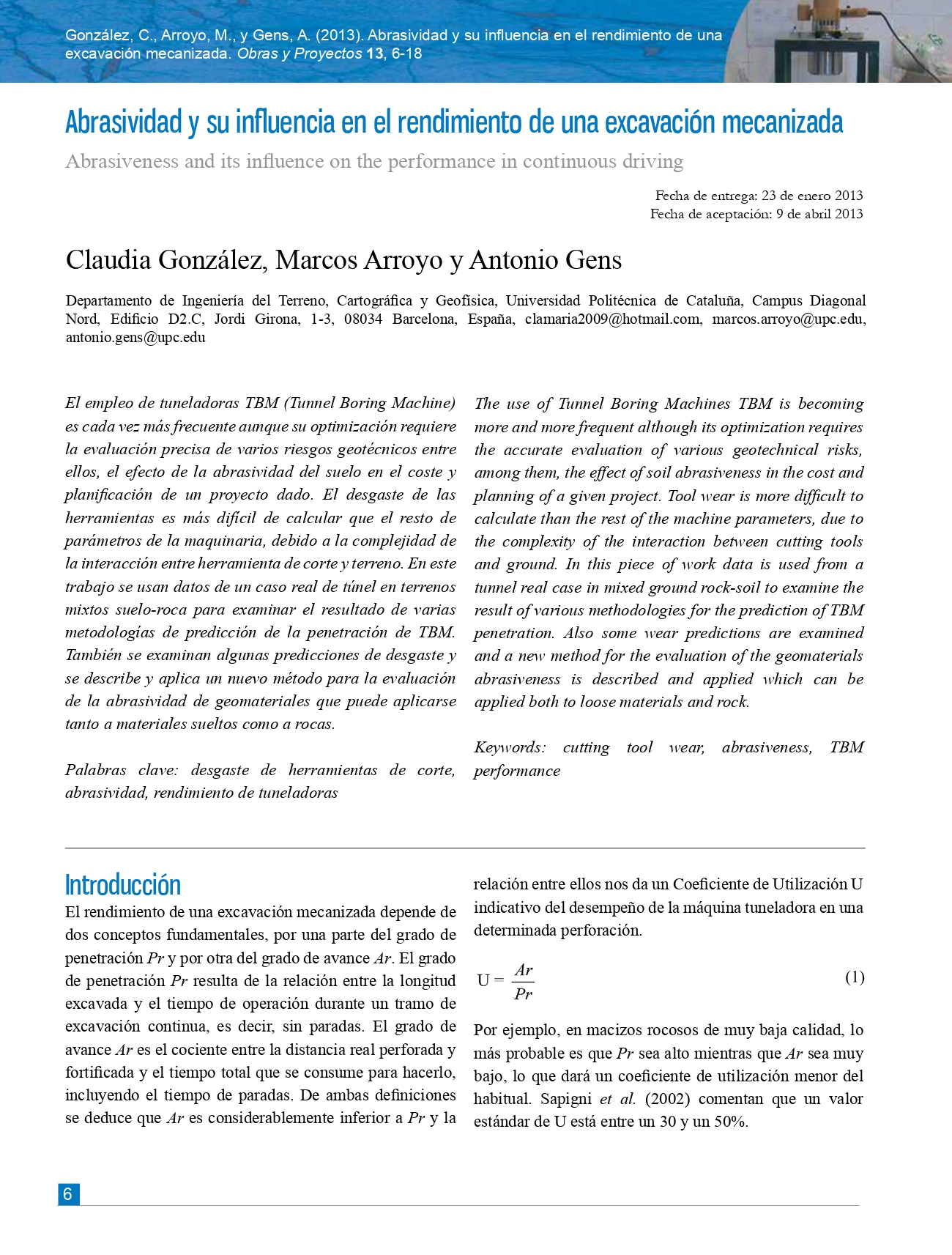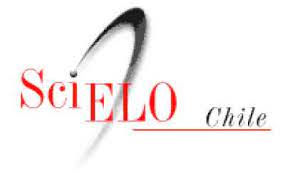Abrasividad y su influencia en el rendimiento de una excavación mecanizada
DOI:
https://doi.org/10.4067/S0718-28132013000100001Palabras clave:
desgaste de herramientas de corte, abrasividad, rendimiento de tuneladorasResumen
El empleo de tuneladoras TBM (Tunnel Boring Machine) es cada vez más frecuente aunque su optimización requiere la evaluación precisa de varios riesgos geotécnicos entre ellos, el efecto de la abrasividad del suelo en el coste y planificación de un proyecto dado. El desgaste de las herramientas es más difícil de calcular que el resto de parámetros de la maquinaria, debido a la complejidad de la interacción entre herramienta de corte y terreno. En este trabajo se usan datos de un caso real de túnel en terrenos mixtos suelo-roca para examinar el resultado de varias metodologías de predicción de la penetración de TBM. También se examinan algunas predicciones de desgaste y se describe y aplica un nuevo método para la evaluación de la abrasividad de geomateriales que puede aplicarse tanto a materiales sueltos como a rocas.
Referencias
AFNOR (1990). Granulats - essai d'abrasivité et de broyabilité. Norme NF P18 - 579.
Bilgin, N. and Balci, C. (2005). Performance prediction of mechanical excavators in tunnels. Estambul, ITAAITES.
Bieniawski, Z.T. (1989). Engineering rock mass classifications. John Wiley and Sons Inc.
Bruland, A. (1998). Hard rock tunnel boring. PhD thesis Norwegian University of Sciences and Technology of Trondheim.
Büchi, E., Mathier, J.F. and Wyss, Ch. (1995). Rock abrasivity - a significant cost factor for mechanical tunnelling in loose and hard rock. Tunnel 5, 38 - 43.
Burger, W. (2006). Hard rock cutterhead design. Proceedings of the North American Tunnelling Conference, 257-263.
Casinelli, F., Cina, S., Innaurato, N. and Mancini, R. (1982). Power consumption and metal wear in tunnel boring machines: Analysis of tunnel boring operations in hard rock. London, IMM, 73-81.
Cerchar (1986). The Cerchar Abrasiveness Index. Centre d' Etudes et Recherches de Charbonnages de France, Verneuil.
Eusebio, A., Grasso, P., Mahtab, A. and Innaurato, A. (1991). Rock characterization for selection of a TBM for a railway tunnel near Geneva, Italy. Proceedings Int. Symp. on Mine Mech. and Automation, Colorado, CSM/USBM,Vol. 1, 4-25 to 4-35.
Farmer, I.W. and Glossop, N.H. (1980). Mechanics of disc cutter penetration. Tunnels and Tunnelling 12(6), 22-25.
Festl, J. (2006). The LCPC test - A possibility to determine soil abrasivity? BA thesis Technische Universitat München (in German).
Frenzel, C., Kasling, H. and Thuro, K. (2008). Factors influencing disc cutter wear. Geomechanik und Tunnelbau 1(1), 55 - 60. https://doi.org/10.1002/geot.200800006
Gehring, K. (1995). Leistungs - und Verschleibprognosen im maschinellen Tunnelbau. Felsbau 13(6), 439-448.
Graham, P.C. (1976). Rock exploration for machine manufacturers. Proceedings of the Symposium on Exploration for Rock Engineering, vol. 1, Johannesburg, Balkema, 173-180.
Gutiérrez Manjón, J.M. (2009). Modo de operación y consumo de cortadores en los terrenos metamórficos y graníticos de los túneles de Guadarrama (AVE), Línea 9 Metro de Barcelona, Vigo (AVE). Barcelona, UPC.
Hughes, H.M. (1986). The relative cuttability of coal measures stone. Mining Science and Technology 3(2), 95-109. https://doi.org/10.1016/S0167-9031(86)90250-1
Kahraman, S., Bilgin, N. and Feridunoglu, C. (2003). Dominant rock propierties affecting the penetration rate of percusive drills. International Journal of Rock Mechanics and Mining Sciences 40(5), 711-723. https://doi.org/10.1016/S1365-1609(03)00063-7
Kasling, H. and Thuro, K. (2010). Determining abrasivity of rock and soil in the laboratory. In Williams et al. (eds.) Geologically Active. Proceedings of the 11th Congress of the International Association for Engineering Geology and the Environment, Auckland, New Zealand, Taylor & Francis, London.
Lien, R. (1961). An indirect test method for estimating the drillability ofrocks. Dr. thesis Trondheim University.
Movinkel, T. and Johannessen, O. (1986). Geological parameters for hard rock tunnel boring. Tunnels & Tunnelling 4, 45 - 48.
Nielsen, B., Dahl, F. and Holzhauser, J. (2006a). Abrasivity testing for rock and soils. Tunnels & Tunnelling International, 47 - 49.
Nielsen, B., Dahl, F. and Holzhauser, J. (2006b). Abrasivity of soils in TBM tunnelling. Tunnels & Tunnelling International, 36 - 38.
Ozdemir, L. (2003). CSM computer model for TBM performance predictions. Colorado School of Mines.
Ozdemir, L. and Wang, F. (1979). Mechanical tunnel boring, prediction and machine design. Finat Report NSF/RA-790161: 204.
Plinninger, R. J. and Restner, U. (2008). Abrasiveness testing, Quo Vadis? - A commented overview of abrasiveness testing methods. Geomechanik und Tunnelbau 1(1), 61-70. https://doi.org/10.1002/geot.200800007
Roxbosough, F.F. and Phillips, H.R. (1975). Rock excavation by disc cutter. International Journal of Rock Mechanics and Mining Sciences 12(12), 361-366. https://doi.org/10.1016/0148-9062(75)90547-1
Sapigni, M., Berti, M., Bethaz, E., Busillod, A. and Cardone, G. (2002). TBM performance estimation using rock mass classifications. International Journal of Rock Mechanics and Mining Sciences 39(6), 771-788. https://doi.org/10.1016/S1365-1609(02)00069-2
Thuro, K., Singer, J., Kasling, H. and Bauer, M. (2006). Soil abrasivity assessment using the LCPC testing device. Felsbau 24(6), 37 - 45.

Descargas
Publicado
Número
Sección
Licencia
Derechos de autor 2013 Universidad Católica de la Santísima Concepción

Esta obra está bajo una licencia internacional Creative Commons Atribución-NoComercial 4.0.







